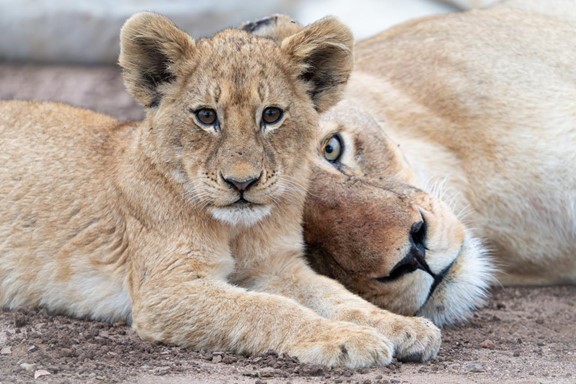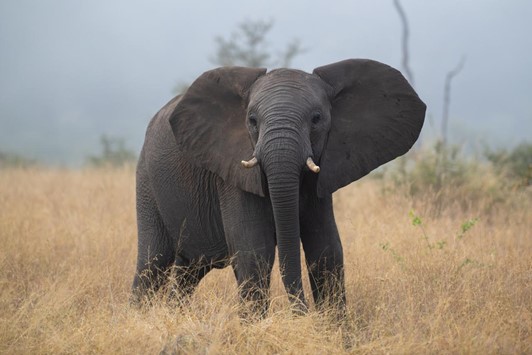June 2024
Singita Kruger National Park
Share:
Singita Kruger National Park: June 2024
Dry season is truly on the go, grasses have turned to a beautiful golden brown and the brush is thinning out nicely. The days are starting later and colder, with everyone bundled up in blankets and ponchos as safaris set out, and yet still by mid-morning the elephants are making their way towards the river for a drink as the heat sets in. The colours of the sunset are crisp red and oranges, as the day gives way to our beautiful clear winter night skies.
A Sightings Snapshot for June follows:
Lions
The Trichardt male, still just one male from what we have seen, has been scarce and when he has been seen he has been quite vocal, announcing his presence to any would-be competitors for the area. Based on the locations he has been found, and the direction he is seen moving in, it seems he is spending the majority of his time near the Mananga lionesses as opposed to the Shish.

The Mananga Pride have not been seen many times this month as they appear to be keeping their cubs along the N’wanetsi River further to the west of our concession, although they have left their tracks for us to find many times, so we know they have been entering the area and exiting again before we have the chance to find them. The females have been seen hunting more regularly than the cubs have been seen, but with each sighting of the cubs we are happy to see that all eight of them are still alive and well.
The Shish Pride is still going strong, but there is a lot of pressure on the seven adult females as their fourteen cubs grow and develop even larger appetites. Although they all seem to be in good condition, they need to be feeding regularly to ensure all the members have adequate food.
The Maputo males have been seen once or twice individually, but most sighting have been together with at least some of the members of the Chava Pride in the north-western reaches of the concession. They were even recently seen making a kill with one of the lionesses, she had initiated the hunt by tackling a large wildebeest bull, and the Maputo male bulldozed in and tackled the prey to the ground to finish it off. The three then fed noisily, growling and bickering constantly through the meal.
The Chava Pride, although initially very nervous of our presence are steadily becoming more accustomed to the vehicles. Some may still appear apprehensive, while other members of the pride are much more relaxed. We have seen this pride, or certain individuals from this pride more frequently this month, often being accompanied by the very attentive Maputo males, even a few mating events have been observed.
An unknown group of lions, including three males and two females were seen in the far northern reaches of the reserve. Also there were a few groups of adult male lions, seemingly working out some politics amongst them, as they have been seen vocalising and chasing each other around, north of the concession.
An unknown young male and female were respectively seen in the southern area of the reserve, assumed to be the sub-adults dispersing from the larger portion of the Mananga Pride, but it is difficult to know for sure with young, independent animals.
Leopards
The Lebombo male leopard has only been seen twice this month, with both sightings being near each other on the river just north of the lodge.
Khalanga male, after a few months hiatus has re-emerged on the reserve, and brought some drama with him. After being seen for the first time in two months, looking healthy and in good condition, he suddenly appeared with his mother, the Dumbana female, and her two young cubs. A very interesting interaction followed, as the Dumbana female growled and grumbled, clearly disgruntled by the presence of her adult male cub now in such close proximity to her new litter, but when she tried to move away, he stood to follow her and he clearly had a bad injury on his back leg. The delight at seeing this young male again was then tainted by worry about whether he would survive this injury. Much to the team’s relief, the wounds appear to be healing and he was even seen in the last few days with a hoisted impala kill upon which he fed for about three days. All good signs for a strong recovery.
The Confluence male is gradually becoming more confident around the vehicles, with a few sightings of him near the lodge, seemingly in a similar area to the Lebombo male.
Nhlangulene female leopard has been seen a few times this month, but only four times, coming as far south as to have met the Dumbana female in one of the sightings. Her independent daughter has also been seen once this month, stalking impala along the rocky ridges alongside the central depression.
As the month has progressed, the Dumbana female together with her two cubs have become a much more regular sighting, where previously we were only seeing the cubs when they were found with their mother on a kill, we are now seeing them moving with her more frequently as they get older and are more mobile.
Nyala female has been reported twice this month, which is much less than we usually see her, however there have been a few sightings of a shy, young female moving around the areas where Nyala would usually be seen.
There have also been a few sightings of some unknown leopard individuals across the reserve, as sightings of this nature are sometimes too swift for the animal to be identified.

African wild dogs
It is denning time again and that is often accompanied by very irregular viewings of the dogs as they always have somewhere more important to be. We expect the large pack of twelve may have pups hidden somewhere within the rocky crevasses of the Lebombo mountain range, and so we have had a few sightings, but the dogs never stay at any one place for too long, and soon disappear.
A small group of eight African wild dogs was seen in the far northern reaches of the reserve which had two females showing enlarged mammary glands, which is interesting because usually within the pack only the alpha female will breed and raise pups. Although it has often been observed that the ‘beta’ female also produces a litter, it is not always certain if any of the pups of the lower ranking female will survive.
Spotted hyenas
Spotted hyena have been a regular sight this month, as usual they are not always easy to predict where to find them, but always exciting to see when you come around the corner in the early evening to find one, and somehow, they are always moving with purpose.
Elephants
Elephant herd and bulls alike have been persistent across the reserve during June.
During the day the families of females with their young close at heel, make regular visits to the river to drink, but as the temperatures cool with the setting sun, we often see the herds making their way to slightly more elevated regions to avoid the bitter cold around the river.

Buffalos
During the month of June, we have seen multiple large herds of buffalos moving through the concession. These herds have numbered into the hundreds, as hoards of the large animals have been seen moving together from grazing areas to water and back. Now that the water sources are becoming scarcer, their movements will become more irregular.
In the drainage lines, where small reserves of water persist and the vegetation is thick and cool, there have been a few lone buffalo bulls seen, seeking shelter from potential predators and the heat during the day, in the dense thickets.
Plains game
A small herd of three eland cows was seen within the concession in June, seen in the mountainous areas around the granophyre ridge.
A small herd of sable were seen in the far north-western region of the reserve.
Rare animals and other sightings
A very exciting report of a Cape clawless otter seen in the river at Dave’s crossing.
A couple of honey badger pairs have been seen, usually moving quickly away from the vehicles with their characteristic trotting gait.
Many pairs of klipspringer can be seen along the rocky ridges overlooking the N’wanetsi River, unfortunately two individuals, possibly an adult with its sub-adult youngster, were killed by a pack of African wild dogs, leaving behind one female which will now need to find a new mate.
Although we often have sightings of the black-backed jackals, having a sighting of a side-striped jackal is much rarer which we enjoyed this month.
Birds
Some Southern ground hornbills have been seen, although their sightings have not been regular.
Unique sightings of a lesser swamp warbler in the river around Dave’s crossing, as well as a fiscal flycatcher further into the central depression, were reported during this month.
A flock of yellow-billed storks, with a few African spoonbills were seen flying at sunset along the river to Mozambique.